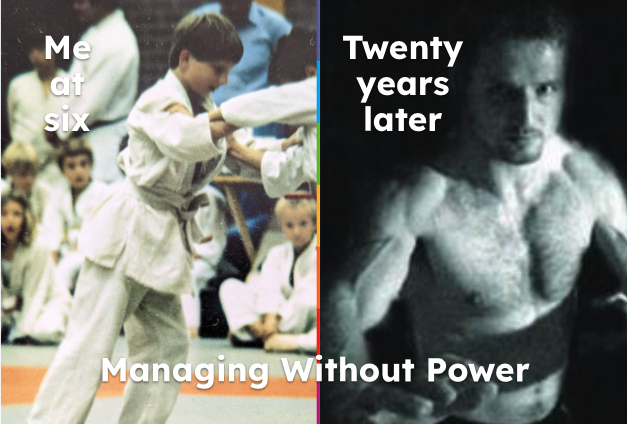Like a martial artist who can't rely on brute strength forever, a leader must balance positional power with soft skills like empathy and trust. This intentional shift—Managing Without Power—is the only way to build a truly high-performing team that is intrinsically motivated.
From the Dojo to the Boardroom
My first judo tournament kicked off a twenty-year martial arts journey expanding into Aikido, Kick-Boxing, Brazilian Jiu-Jitsu and Mixed Martial Arts.
This background taught me to see parallels between martial arts, professional life and leadership. One insight, which I discovered while teaching judo to kids, became the reason I titled my work "Managing Without Power."
When Strength Becomes a Weakness
Some kids are naturally stronger than others. They learn early on that they can overpower opponents and win most matches with brute force. But as they move up in the ranks, this strategy eventually fails. At higher levels, all fighters are physically strong. The ones who keep winning learned early NOT to rely on their strength when it’s less effective. Instead, they developed skills like reading an opponent’s movements, surprising them, and creating a strategic game plan.
The Power in Leadership
The same is true for leadership. Yes, to lead at the highest levels, you need to be able to exert power. This includes:
🚀 Making tough decisions
🚀 Demonstrating strength and resilience under pressure
🚀 Developing a thick skin
🚀 Working hard
🚀 Being willing to push people at times
🚀 Firing people when necessary
So, there's nothing wrong with having power as a leader, just as a competitive fighter needs to be physically strong.
The Skills Power Can't Teach
The problem is that your power can easily become a trap. Power makes it easy to talk too much and listen too little. It allows you to push through ideas without genuinely engaging people based on their own motivations. Team members will accept it if you regularly show up late or unprepared for meetings. Meanwhile, they'll politely follow your lead, but they won't truly flourish.
The cost is clear: less intrinsic motivation, less constructive dissent, and a loss of crucial connection. The important signals stop getting through.
Reverse this process by regularly choosing to let go of your power. Systematically dedicate time to your team, show up prepared and on time, listen actively, and be consistently interested. In return, you'll see a sense of ownership growing in your team, making micromanagement unnecessary. Seeing your team work productively will lead you to admire their unique skills. You'll express appreciation more frequently and authentically. Furthermore, a strong relationship of trust allows you to deliver difficult feedback far more effectively. It's a win for everyone!
The Path to a High-Performing Team
If you rely too much on your authority, people will follow you because of your position. When you let go of your power more often and consistently invest in your team, they will follow you because of who you are and what you represent. The five 'Brilliant Basics' below will help you achieve this:
🚀 Meaningful Conversations about Personal Growth, Career, and Life: Dedicate ample time for career conversations. Take them out of the office—go for coffee or a walk in the park. Broaden and deepen the content so you can see the whole person.
🚀 Collaboratively Clarify Direction and Expectations: Cascade a clear strategy from the organization to the team to the individual (using a framework like OKRs, for example). Create a context where your team feels safe to challenge strategy and contribute to it. Spend less time creating and presenting strategy slides and more time talking with your team about what the strategy means for their day-to-day choices.
🚀 Discuss and Cultivate Healthy Team Norms: Hold a structured conversation with your team about the most effective ways to work together: How do you make all meetings effective? Which communication channels do you use and when? How do you handle remote work? etc. Cultivate these team norms until they become a lived team culture: Be a role model, publicly celebrate positive behaviors from team members, and be consistent in correcting undesirable behavior.
🚀 Track Progress and Adjust Course: Spend enough time with your team to spot when they are getting stuck, but also to recognize when things are going well, so you can compliment people on the spot. Twice a quarter, score progress on agreed-upon goals with your team and provide people with continuous feedback.
🚀 Fair and Predictable Performance Reviews: If you consistently implement the points above and clearly define the criteria for evaluating performance, a performance review becomes nothing more or less than a summary of what has already been discussed throughout the year. The final rating will be one your team members already anticipate. They will have received the feedback when they still had a chance to act on it. The outcome is well-informed and as free from bias as possible.
You'll know you've succeeded when your team:
✅ Attracts and retains the best talent
✅ Is proactive and collaborative
✅ Sets a high bar for themselves, instead of you having to remind them
✅ Challenges you and defines strategy with you, rather than just complaining
✅ Owns work and plows through barriers without dropping the ball
✅ Gives you honest feedback to help you grow into the best leader you can be
Using power can feel like the faster route, especially when you're busy and under pressure. But once you've experienced what it's like to run a truly high-performing team, you'll never regret the investment you made!
Do you want to create leaders who build high-performing teams? Plan an introduction meeting with me here.



